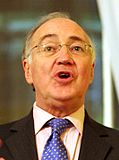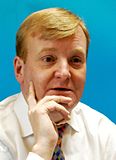UK General Election, 2005
|
|
|||||||||||||||||||||||||||||||||||||||||||||||||
|
|||||||||||||||||||||||||||||||||||||||||||||||||
|
|
|||||||||||||||||||||||||||||||||||||||||||||||||
|
All 646 seats to the House of Commons 324 seats needed for a majority |
|||||||||||||||||||||||||||||||||||||||||||||||||
|---|---|---|---|---|---|---|---|---|---|---|---|---|---|---|---|---|---|---|---|---|---|---|---|---|---|---|---|---|---|---|---|---|---|---|---|---|---|---|---|---|---|---|---|---|---|---|---|---|---|
| Opinion polls | |||||||||||||||||||||||||||||||||||||||||||||||||
| Turnout | 61.4% ( |
||||||||||||||||||||||||||||||||||||||||||||||||
|
|||||||||||||||||||||||||||||||||||||||||||||||||

Colours denote the winning party, as shown in the main table of results.
* Indicates boundary change – so this is a nominal figure ‡ Figure does not include the speaker |
|||||||||||||||||||||||||||||||||||||||||||||||||
|
|||||||||||||||||||||||||||||||||||||||||||||||||
* Indicates boundary change – so this is a nominal figure
The 2005 United Kingdom general election was held on Thursday, 5 May 2005 to elect 646 members to the House of Commons. The Labour Party led by Tony Blair won their third consecutive victory, but their majority now stood at 66 seats compared to the 160-seat majority it had previously held. As of 2018, it remains the last general election victory for the Labour Party.
The Labour campaign emphasised a strong economy; however, Blair had suffered a decline in popularity even before the decision to send British troops to invade Iraq in 2003. The Conservative Party, led by Michael Howard since late-2003, campaigned on policies, such as immigration limits, improving poorly-managed hospitals and reducing high crime rates, all under the slogan "Are you thinking what we're thinking?". The Liberal Democrats, led by Charles Kennedy, were opposed to the Iraq War given that there had been no second UN resolution, and collected votes from disenchanted Labour voters.
Tony Blair was returned as Prime Minister, with Labour having 355 MPs, but with a popular vote of 35.2%; the lowest of any majority government in UK electoral history. In terms of votes, they were only narrowly ahead of the Conservatives, but still had a comfortable lead in terms of seats. The Conservatives returned 198 MPs, with 32 more seats than they had won at the previous general election, and won the popular vote in England, while still ending up with 91 fewer MPs in England than Labour; this indicated the party lost many close races and won landslides in its heartland. The Liberal Democrats saw their popular vote increase by 3.7% and won the most seats for any third party since 1923, with 62 MPs. Anti-war activist and former Labour MP George Galloway was elected as the MP for Bethnal Green and Bow under the Respect – The Unity Coalition banner; Richard Taylor was re-elected for Kidderminster Health Concern in Worcestershire; and independent candidate Peter Law was elected in Blaenau Gwent.
...
Wikipedia



